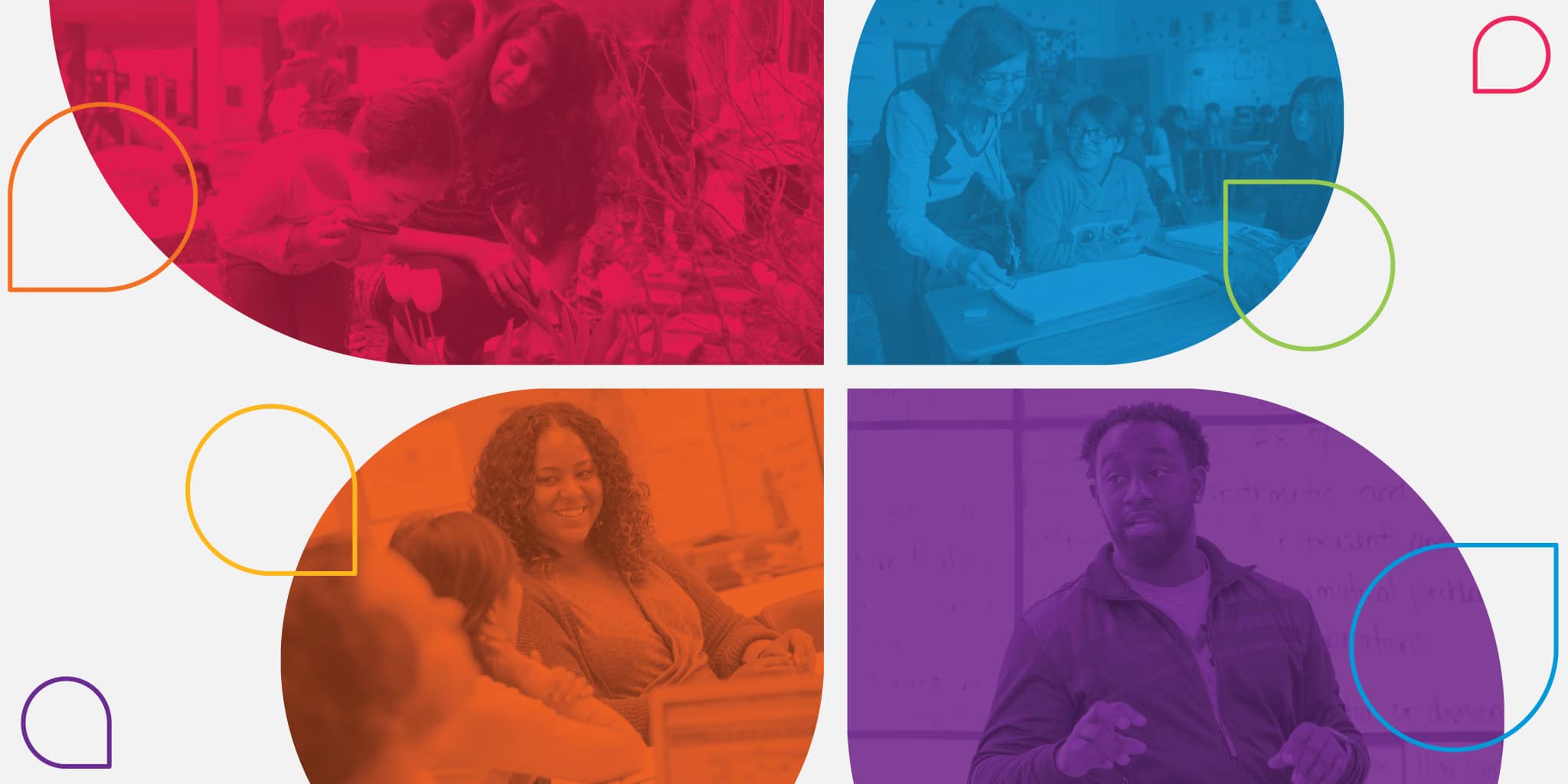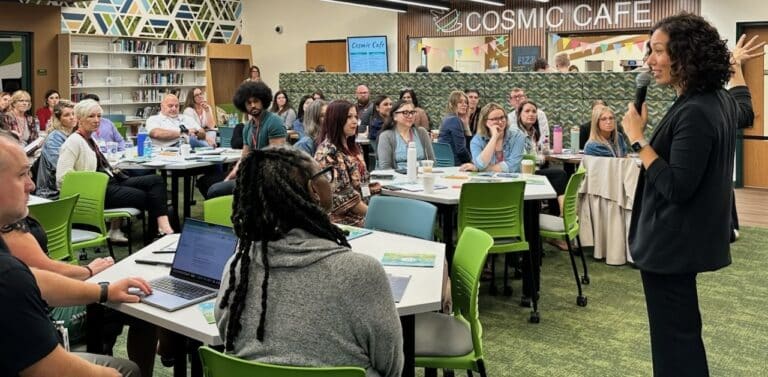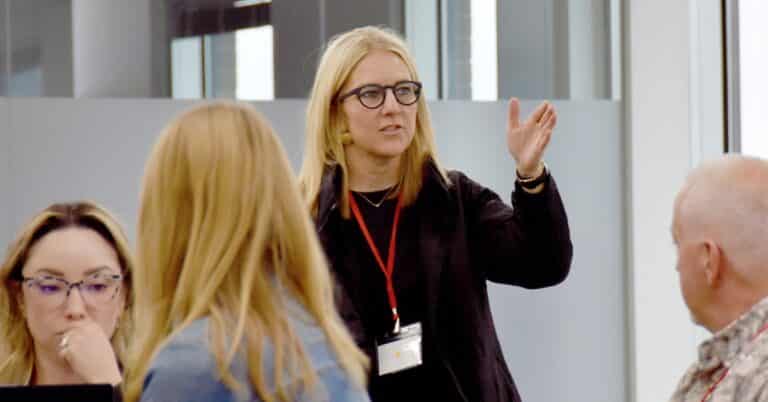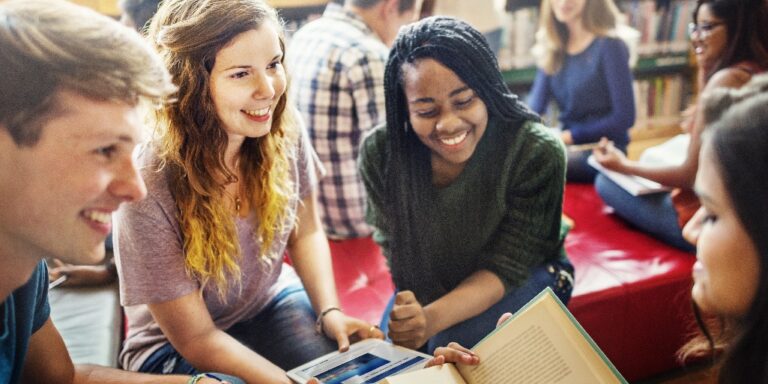While shifting practices in the classroom is still a critical part of implementing personalized, competency-based learning, a good leader can ensure long-term sustainability and systems-level change.
For Theresa Ewald, former assistant superintendent of Kettle Moraine School District in Wales, Wisconsin, her true passion is in coaching leaders to realize their visions for a more student-centered approach. After retiring with more than 30 years of experience as an educator and administrator, she recognizes the power of shifting thinking about instructional leadership.
“I believe in modeling and culture to my core, and that starts with changing how we lead.” — Theresa Ewald
Bob Knisely, a middle school principal with Perry Local Schools in Perry, Ohio, agrees that it’s important to model behavior and set an example for other teachers and leaders to follow as they advance in their own careers. Knisely, recently named the Ohio Principal of the Year, said, “You do things how you’ve experienced them,” and credits the modeling of his principal when he was a classroom teacher for instilling this in him. “Especially at first, when you don’t know any better. That’s served me well.”
Below are insights for leaders, from leaders, to support a shift to a more personalized, competency-based learning environment.
For educators to let go of control in the classroom, leaders and administrators have to cede power, too.
“We can’t have teachers do for kids what we don’t do for teachers,” said Ewald. “We can’t have a top-down management strategy or script all their stuff and expect them to do differently with kids.”
Distributed leadership, where decision-making happens via a group versus a single person, is an example of what this kind of leadership approach can look like. Deion Jordan, a teaching and learning director at KnowledgeWorks, saw this in action in his previous role at Crosstown High School in Memphis, Tennessee.
“During my time at Crosstown High, we’d been in a state of stagnation, focused on administrative tasks as opposed to instruction. The leadership team made the decision to forgo the traditional principal role and opted for distributed leadership, or holistic leadership,” said Jordan, former director of competency-based learning with Crosstown High School. “We created an instructional leadership team tasked with oversight of three primary areas: competency-based learning, project-based learning and pedagogy, while also empowering our strongest teachers to lead grade-level teams and academic departments.”
Jordan said the school’s shared vision held everyone accountable to the strategic plan, and to have an active role in continuous quality improvement. This distributed leadership approach enabled staff to distribute the learning, innovating, action and accountability across a group of capable individuals, including learners.
Educators know what they need. Ask and listen.
After attending a parent-teacher conference for his son and really taking a closer look at the way student engagement takes a dive after third or fourth grade, Knisely wanted to change that trajectory. But he didn’t start by proposing solutions. He started with listening.
“Pre-COVID-19, I started to do a deep dive on ways to increase student achievement,” said Knisely. “I was having conversations with teachers over six to eight months, asking them things like, what would the perfect classroom look like for you? Sound like? What would kids be doing? What barriers would I need to remove? The more teachers I engaged in those conversations, the more consensus developed around what learning would look like if we removed barriers and gave them the opportunity to teach the way they felt kids needed to be instructed.”
Perry Local Schools’ approach at the middle school, called connected and authentic learning, is a system built around access, agency and meaningful choices. And while the Connected and Authentic Learning Academy began as a school within a school approach, Knisely explained that it grew organically to include nearly all fifth and sixth grade teachers. Additionally, to meet a goal to ensure 100 percent exposure to authentic learning, all core teachers in all grades participate in school-wide, interdisciplinary authentic learning experiences once per semester.
“Last year our school action goal was to collect, capture and celebrate all the authentic learning experiences that are happening. We wanted to ensure every kid was getting exposed to learning opportunities and had the ability to experience authentic learning,” Knisely said. “It emerged very quickly that when we were doing the research. The comment kept coming up from teachers, ’We would do this regardless of whether it’s a thing because it’s good teaching.’”

For long-term change, create a culture of sustainability.
What educators experience and come to believe about school culture and climate are a result of what’s been modeled by the leaders in their school or district.
“Just like teachers are modeling for kids, we’re modeling for teachers. Next year’s principals are this year’s teachers,” Ewald said.
Ewald recognizes that she wasn’t trained to create the space for culture. “Nobody talked to me about that, it was just about having a vision, making an action plan, monitoring my people. But we need to rethink leadership in this new frame: a true system of personalization, a system of agency, for everyone.”
Knisely endeavors to stay connected with the experiences of educators and learners, and co-taught one of Perry Local Schools’ authentic learning classes last year.
“That was really good experience; it got me back to where I was 15 years ago in the classroom,” said Knisely. “It allowed me to experience what the teachers were experiencing in getting the kids to shift their mindsets, try to break the habits we’ve ingrained in them since preschool and kindergarten.”
Just like teachers are modeling for kids, we’re modeling for teachers. Next year’s principals are this year’s teachers.
Building this kind of shared vision and culture is, according to Jordan, essential for second-order change – which he describes as making the kinds of changes that are fundamentally and categorically different from the way things have been done. “With second-order change, you’re not just deciding to do something different. There is a well-developed, intentional, authentic plan that is structured in a way that creates a process of irreversibility,” said Jordan. “When you’re acting with intentionality, it’s impossible to return to the old way of doing things.”
“Coaching leaders to understand and recognize the differences and nuances of first versus second order change is vital, alongside the development and fostering of a culture of transparency,” Jordan said. In addition to a feeling of connection and a sense of accountability, a vision that includes an understanding that risk-taking and failure are a part of the process ensures sustainability.
“Creating a well-regulated green light culture that embraces failure and success while providing many opportunities for feedback, mentorship, modeling and coaching is vital to achieving your goals,” said Jordan. “Everyone from educators, learners, bus drivers and administrative assistants must see themselves as a part of the vision and understand their unique role in actualizing it.”
And when leaders move on – because they will – their legacy is that they’ve built up others and created something that can outlast change.
Remove barriers when you can. Co-create solutions when you can’t.
“I see myself as a shield and as a person who is able to do the things that a classroom teacher can’t do,” said Knisely. “If it’s going to be good for kids and good for learning, it’s about finding ways to do that. I can remove barriers. I can get creative with the schedule.”
For Knisely, partnership and open lines of communication are critical.
“I may not have the answer, but we’ll collaborate the heck out of a problem until we come up with a solution that works for us.”
Collaborative problem-solving includes engaging in evaluation and data-driven continuous improvement throughout the school or district, from policies and practices to the master schedule and bulletin boards.
“At Crosstown High, we often deployed a pre-mortem protocol where we attempted to anticipate our failures and successes with or without the use of data-points to ensure we designed the best possible policy or procedure for our learning community,” said Jordan. “We were also adaptive leaders that sought to ensure we were flexible in our support of our teachers. One moment, we could be a mentor, another a coach. Sometimes just a friend deeply listening. The role of leader is evolutionary. One’s ability to respond to a myriad of situational needs is fundamental.”
Understand the role of the leader.
Strong leadership can make or break a shift to personalized, competency-based learning and a more student-centered approach. Investing in leadership training and focusing on mindset shifts at the outset can help create sustainable transformation.
“When people started visiting Kettle Moraine, I could step back and listen to my teachers talk about the culture they worked in and realize that we built that. It wasn’t a Theresa thing,” said Ewald. “And when I left the district, the practices were so ingrained and so deep that a leadership change didn’t have the impact I thought it would have. People come to Kettle Moraine and they say, ‘I’ve never felt a school like this.’ Our kids love their school. People feel that. Experiencing that kind of a learning environment is an opportunity to feel hope.”
This was written by former Senior Manager of Communications Jillian Kuhlmann.





